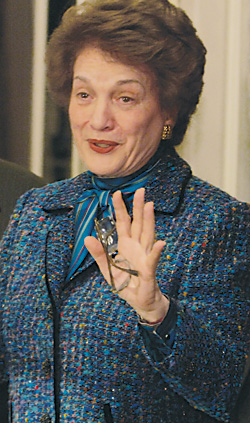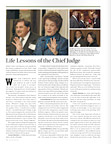Life Lessons of the Chief Judge
Editor’s note: In January 2007, two months before being reconfirmed as New York’s chief judge, Judith Kaye ’62 gave the keynote at the Annual Alumni Luncheon. Here is an excerpt from her crowd-pleasing speech.
Printer Friendly Version When our fabulous dean invited me to deliver the keynote address, he said it would allow me to give “a retrospective of over two decades” of my career on the bench. Making full use of chief judge’s prerogative, I’ve gone back even farther to share six of my life lessons.
When our fabulous dean invited me to deliver the keynote address, he said it would allow me to give “a retrospective of over two decades” of my career on the bench. Making full use of chief judge’s prerogative, I’ve gone back even farther to share six of my life lessons.
My parents, immigrants from Eastern Europe, were first farmers and later shopkeepers in Monticello, New York, where I was born. I attended a one-room schoolhouse. Whatever image you may have about one-room schoolhouses, I skipped two grades when I transferred to public school. I attended Barnard College at age 15. You cannot imagine the enormity of the adjustment from Monticello to Manhattan. I remember the inkblot test they gave entering Barnard freshmen. I saw a rooster. The person next to me wrote “Dante’s Inferno.”
The single luckiest thing that happened to me at Barnard, maybe in my entire life, is that I came down with the mumps and had to miss my first exams. But for the mumps, I likely would have flunked everything and been back in Monticello for good.
Lesson Number 1: A little adversity sometimes can be a blessing.
In high school, I made the decision to be a journalist. I majored in Latin American studies at Barnard and saw myself as a journalist making and shaping world opinion in the capitals of Latin America.
After innumerable rejections, I found a job reporting weddings, church socials and women’s club meetings. Not the stuff of Pulitzer Prizes. Before long, I began to rethink my life and in desperation enrolled at the Law School at night with a day job editing copy for a feature syndicate. My sole ambition was to get off the social page, and law school seemed a sure-fire way in the 1960s for a woman to be taken seriously in the male-dominated profession of journalism.
Lesson Number 2: Every now and then it’s good to reconsider the life-course you’re on.
With a demanding daytime job, for me night law school was hardly a breeze. My assigned seat in Civil Procedure happened to be next to the class genius, a particularly brilliant engineer. When the grades came back on Delmar Karlen’s mid-year exam, my engineer friend and I were both shocked: My grade was at the top of the class, his at the bottom. He had written flawlessly about the law of contracts, which was the context of the exam hypothetical. My response was about the credibility of witnesses.
Lesson Number 3: Before you go spouting off on a subject, first be sure you know what the topic of the discussion is.
It was near-impossible to find a law-firm job. “Our quota of women is filled” was a common response—meaning, they had a woman, a quota, or both. Naturally, I aimed for one of the completely impenetrable Wall Street firms. My wonderful classmate Roberta Karmel ’62 asked me, “Judy, why are you doing this? They don’t want us!”
After scores of rejections, I was hired by the venerable firm of Sullivan & Cromwell—the only female in its litigation department. Departmental meetings began, “Gentlemen and Judy.” Why on earth Sullivan hired me is one of the great mysteries, and great joys, of my life.
Lesson Number 4—mine and Yogi Berra’s: When you reach a fork in the road, take it. It’s no time to pause for reflection, or be timid, or ask too many questions, or study the odds. Just go for it!
I have now marked 23-plus years as a judge of New York State’s highest court, 14 of those as chief judge. Let me assure you, nothing comes close to the privilege of being chief judge.
One of the most important reforms to our court system during my tenure has been jury reform. My official reason for focusing on the jury system is that it is a singular opportunity to show the public that our justice system works well. We call more than 650,000 potential jurors every year. That’s a lot of opportunity to win public trust and confidence. My unofficial reason is that years ago my NYU Law School graduate daughter Luisa ’91 called me during a break from jury service to say: “Mom, this is a great place to meet guys.” Immediately I resolved to expand the array.
We began the process with a commission of lawyers, judges and members of the public, who within six months handed me a terrific blueprint for reform. Indeed, the commission process has been a hallmark of my years as chief judge—an extraordinary route to effective reform throughout our court system.
Lesson Number 5 echoes Margaret Mead: “Never doubt that a small group of thoughtful, committed citizens can change the world. Indeed, it is the only thing that ever has.”
As a quick example of profound change affecting the courts, consider the drug epidemic and its impact on our criminal-court and family-court dockets. Probably threequarters or more of our criminal cases are drug-driven, many of them low-level offenders committing nonviolent crimes again and again simply to support a drug habit. Or consider the huge child-neglect and abuse dockets and record numbers of children being removed from their homes to enter foster-care limbo. There was a public outcry: “Do something.”
I’m proud to say we have done a lot. Today in New York State we have 152 Drug Courts, offering rehabilitation instead of jail; we have Family Drug Courts to speed rehabilitation and avoid the need to terminate parental rights, and Juvenile Drug Courts for vulnerable teenagers. We have Integrated Domestic Violence Courts throughout the state focused on victim safety and offender accountability; we have Mental Health Courts to reroute people in need of treatment from prison; we have Community Courts, Reentry Courts and many more specialty courts, and, best of all, we have a Center for Court Innovation—a research and development arm to help us think through these new approaches to delivering justice.
Are those without controversy? Of course not. Nothing worthwhile in life is. We are sensitive to the criticisms when they are valid. But we also have tremendous antidotes: the thanks of people who have been served by these courts and have been able to turn their lives from the downward spiral they were on; the enthusiasm of our judges who say, “This is what I became a judge to do,” and nationwide and worldwide interest in replicating our courts.
Lesson Number 6, the words of the late South African lawyer, soldier and statesman General Jan Christian Smuts: “When enlisted in a good cause, never surrender, for you can never tell what morning reinforcements… will come marching over the hilltop.”
—
All 2007 Features
All of 2007 Alumni Almanac
